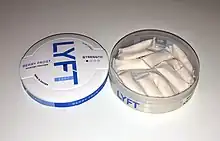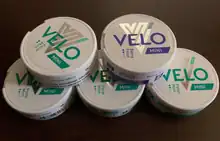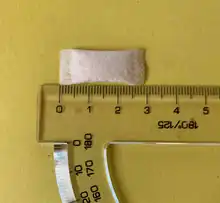



Nicotine pouches, also called modern oral nicotine products, are white pouches containing nicotine among other ingredients. They do not include tobacco leaf, dust, or stem.[1] The nicotine may either be derived from tobacco plants or may be synthetic. Nicotine pouches are described as either similar to or a tobacco-free version of snus.[1][2][3]
To use a nicotine pouch, the user puts a pouch between their lip and gum, and leaves it there while the nicotine and taste is being released.[4] When finished, the pouch is disposed of.[4] Many brands have a storage area in the top case (a catch lid) where used pouches can be kept if no trash can is readily available. The small pouches are not like chewing tobacco, as the user does not need to spit, since the contents of the pouches stay inside the pouches during use.[5][1] No combustion is involved during use.[1]
There is limited independent testing of the constituents, exposure, or biomarkers of effects for nicotine pouches,[1] although independent research is now emerging.[6][7] The pouches are sold in an array of flavors.[1] Many of the brands of nicotine pouches are made by major big tobacco companies (e.g., Swedish Match makes Zyn and Volt, British American Tobacco makes Lyft and Velo, Imperial Tobacco makes Skruf and ZoneX, Japan Tobacco International makes Nordic Spirit, Philip Morris International makes Shiro, and Altria owns 100% of On!).[8] In December 2020 and April 2021, Altria subsidiaries closed transactions to acquire the remaining 20% of the global On! business for a total of approximately $250 million.[9][10][11]
Usage
While relatively new, nicotine pouches share similarities with Swedish snus. The first pouch product was developed in the beginning of the 2000s by a small start up company Niconovum. This company registered the product in 2008 as a medicinal nicotine replacement product (Zonnic) with 2 mg of nicotine. In 2009, RJ Reynolds (now British American Tobacco) bought Niconovum. Thereafter tobacco companies, particularly Swedish Match, became active in the pouch category. Many of Sweden’s leading snus manufacturers, such as Swedish Match, Skruf and AG Snus created their nicotine pouch brands (ZYN, Shiro, Swave etc) as a direct response to demand for a nicotine option with less conspicuous, smokeless usage. While discreet and tobacco-free, nicotine pouches can still, potentially, cause some side effects like: hiccups, gum irritation, nausea and headaches. [12]
It is unclear whether smokers might switch to nicotine pouches or if they would continue to smoke and use nicotine pouches, resulting in dual use.[1] Nicotine pouches typically cost about as much as a pack of regular cigarettes.[1] Unlike vaping products, they require no batteries and no accessory device.[1]
Nicotine pouches may entice youth as well as young adult never-smokers because they are available in an array of flavors and may be used unobtrusively.[1]
In pharmacies in Norway, Finland, Denmark, and Sweden, nicotine pouches are also sold as a delivery mechanism for nicotine replacement therapy. In Norway, the brand Zonnic is approved by the Norwegian Medicines Agency for smoking cessation.[13][14]
Contents
In addition to nicotine, the pouches typically contain food-grade fillers, sweeteners, and flavorings.[1] The main ingredient in nicotine pouches in terms of volume is plant fiber. Plant fibers are used to fill the pouch and give it the desired shape, fit, and properties. Different brands use different fibers, but some of the most common derive from eucalyptus and pine.[15] Nicotine pouches are sold in an array of flavors, such as peppermint, black cherry, coffee and citrus, among many others.[1] The nicotine content among nicotine pouch brands typically varies from 1 mg/pouch to 10 mg/pouch[16] although some have much more. Nicotine pouches usually have a longer shelf-life than traditional snus.[17]
Research
Nicotine pouches contain the addictive chemical nicotine.[5]
While nicotine is not a carcinogen according to the International Agency for Research on Cancer,[18] a meta-analysis paper by members of Tata Memorial Hospital in Mumbai, India, state that nicotine may be carcinogenic and has widespread adverse effects on many systems of the body.[19] According to the Royal College of Physicians nicotine in itself is not a highly hazardous drug. RCP also states that it is unlikely that nicotine itself contributes significantly to the mortality or morbidity caused by smoking, and that if nicotine could be delivered to smokers without smoke, most, if not all of the harm of smoking can probably be avoided.[20]
Opposition
Advocacy groups opposed to the introduction of nicotine pouches in Kenya have protested that they may raise the risk of cancer, heart disease, and reproductive or developmental harms.[21] The Kenya Tobacco Control Alliance alleged that given the higher levels of some toxic chemicals, and what the U.S. Food and Drug Administration said was a lack of medical data showing the pouches are safer than cigarettes (as claimed by manufacturer British American Tobacco), the government should not license the product.[21]
Classification
Nicotine pouches are regulated differently around the world. In some countries, like Norway, their sale in general stores are banned because they are classified as a new nicotine product. In other countries, they are sold freely, because they do not classify as a tobacco product due to their lack of tobacco.[22] They are banned in Germany, but are available in Sweden. Although nicotine pouches are not heavily regulated in the European Union, some regulatory characteristics fall under the European Union CLP-Regulation (EC) 1272/2008.[23][24]
It is assumed nicotine pouches are classified as tobacco products in the US because they contain nicotine obtained from tobacco.[1]
Tobacco-free nicotine pouches were for sale in Norway from 2014 to 2018, under the name Epok.[25] In June 2018 the Norwegian Directorate of Health forced British American Tobacco Norway to remove Epok from sale. The Norwegian Directorate of Health argued that since Epok didn't contain any tobacco, it was a new form of nicotine product, distinct from the other forms of snus approved in Norway. Approval for the nicotine pouch brand ZYN had already been rejected twice for a very similar product.[26] Within days of the ban, Epok was re-introduced to the Norwegian market, with a minute amount of bleached tobacco added, to qualify as snus, an already approved form of nicotine product.[27] As of July 2022, Epok is still sold by Norwegian grocery stores.[28][29]
In Canada, nicotine products with a standard dosage exceeding 4 milligrams are considered a prescription drug, therefore personal imports of nicotine pouches containing over 4 milligrams of nicotine per pouch are prohibited.[30] Exceptions exist for those who are a health practitioner or medical practitioner, a drug manufacturer, a wholesale druggist, a pharmacist, or a resident of a foreign country while a visitor in Canada.[31][32]
In Finland, until April 2023, nicotine pouches were classified for medicinal use.[33] The Finnish Medicines Agency (FIMEA) stated that nicotine pouches cannot be classified as medicinal products unless they are specifically marketed for a medicinal purpose or it can be demonstrated in some other way that they are typically used as medicinal products.[33]
References
- 1 2 3 4 5 6 7 8 9 10 11 12 13 Robichaud, Meagan O.; Seidenberg, Andrew B.; Byron, M. Justin (21 November 2019). "Tobacco companies introduce 'tobacco-free' nicotine pouches". Tobacco Control. 29 (e1): e145–e146. doi:10.1136/tobaccocontrol-2019-055321. PMC 7239723. PMID 31753961.
- ↑ Klausen, Marte (25 July 2018). "Bråstans for snus uten tobakk". Dagbladet.no (in Norwegian). Retrieved 2 February 2020.
- ↑ "LYFT | Vitt utan Tobak! | Nettotobak!". Nettotobak.com. Retrieved 3 February 2020.
LYFT är det senaste inom helvitt snus
- 1 2 How to Use Nicotine Pouches
- 1 2 Buehler, Hannah (16 October 2019). "Concern over nicotine pouches targeting teens". WKBW-TV. Archived from the original on 18 October 2019. Retrieved 25 November 2019.
- ↑ Stanfill, Stephen; Tran, Hang; Tyx, Robert; Fernandez, Carolina; Zhu, Wanzhe; Marynak, Kristy; King, Brian; Valentín-Blasini, Liza; Blount, Benjamin C.; Watson, Clifford (18 August 2021). "Characterization of Total and Unprotonated (Free) Nicotine Content of Nicotine Pouch Products". Nicotine & Tobacco Research. 23 (9): 1590–1596. doi:10.1093/ntr/ntab030. ISSN 1469-994X. PMID 34233354.
- ↑ Lunell, Erik; Fagerström, Karl; Hughes, John; Pendrill, Robert (8 October 2020). "Pharmacokinetic Comparison of a Novel Non-tobacco-Based Nicotine Pouch (ZYN) With Conventional, Tobacco-Based Swedish Snus and American Moist Snuff". Nicotine & Tobacco Research. 22 (10): 1757–1763. doi:10.1093/ntr/ntaa068. ISSN 1469-994X. PMID 32319528.
- ↑ "Nicotine Pouches". TobaccoTactics. Retrieved 11 October 2022.
- ↑ "Nachrichten – Weitere Nachrichten". Wallstreet Online (in German). Retrieved 6 May 2023.
- ↑ "Altria Reports 2021 First-Quarter Results; Reaffirms 2021 Earnings Guidance; Acquires Remaining 20% of Global on! Business". Wallstreet Online. Archived from the original on 14 June 2021. Retrieved 6 May 2023.
- ↑ "Altria Reports 2022 Fourth-Quarter and Full-Year Results; Provides 2023 Full-Year Earnings Guidance; Announces New $1 Billion Share Repurchase Program". Wallstreet Online. 1 February 2023. Retrieved 6 May 2023.
- ↑ Nicotine Pouch Side Effects Prilla.com January 2023
- ↑ "Zonnic Niconovum munnpulver i porsjonspose - Felleskatalogen Pasientutgave". www.felleskatalogen.no. Archived from the original on 3 February 2020. Retrieved 3 February 2020.
- ↑ "Røykeslutt - legemidler - helsenorge.no". helsenorge.no. 19 June 2018. Archived from the original on 3 February 2020. Retrieved 3 February 2020.
- ↑ "What are Nicotine Pouches? Complete Guide - Swenico". 9 February 2023. Retrieved 16 February 2023.
- ↑ Stanfill, S.; Tran, H.; Tyx, R.; Fernandez, C.; Zhu, W.; Marynak, K.; King, B.; Valentín-Blasini, L.; Blount, B. C.; Watson, C. (September 2021). "Characterization of Total and Unprotonated (Free) Nicotine Content of Nicotine Pouch Products". Nicotine & Tobacco Research. 23 (9): 1590–1596. doi:10.1093/ntr/ntab030. PMID 34233354.
- ↑ Difference between Nicotine Pouches and Snus SnusDirect February 2021
- ↑ "IARC Monographs on the Identification of Carcinogenic Hazards to Humans". International Agency for Research on Cancer. World Health Organization.
- ↑ Mishra, Aseem; Chaturvedi, Pankaj; Datta, Sourav; Sinukumar, Snita; Joshi, Poonam; Garg, Apurva (2015). "Harmful effects of nicotine". Indian Journal of Medical and Paediatric Oncology. 36 (1): 24–31. doi:10.4103/0971-5851.151771. PMC 4363846. PMID 25810571.
- ↑ "Nicotine without smoke: Tobacco harm reduction". Royal College of Physicians.
- 1 2 Kabale, Nasibo (8 June 2019). "Lobby alleged the introduction of pouches could result in increased risk for cancer". Daily Nation. Archived from the original on 2 December 2019. Retrieved 24 November 2019.
- ↑ Vitásek, Petr (30 September 2020). "Zrádné nikotinové sáčky nepodléhají zákonné regulaci a mohou vést k závislosti". Deník.cz (in Czech). Retrieved 29 June 2021.
- ↑ "EUR-Lex - 02008R1272-20211001 - EN - EUR-Lex". eur-lex.europa.eu. Retrieved 6 April 2022.
- ↑ "Nikotiinipussien etämyynti Suomessa - Snuush - vahvat nikotiinipussit reseptillä" (in Finnish). 20 March 2022. Retrieved 6 April 2022.
- ↑ "Why did BAT kill the EPOK brand for LYFT?". SnusCENTRAL. 18 March 2019. Archived from the original on 3 February 2020. Retrieved 3 February 2020.
- ↑ Journalist, Lene Skogstrøm (25 July 2018). "Denne snusen blir nå trukket tilbake fra hyllene. Årsak: Den inneholder ikke tobakk". Aftenposten. Retrieved 3 February 2020.
- ↑ Klausen, Marte (26 July 2018). "Disse snusboksene forsvinner fra butikkene". Dagbladet.no (in Norwegian). Retrieved 3 February 2020.
- ↑ "Epok | Meny.no". www.meny.no (in Norwegian). Retrieved 3 February 2020.
- ↑ "Epok - Kolonial.no". Kolonial.no (in Norwegian Bokmål). Retrieved 3 February 2020.
- ↑ "Consolidated federal laws of Canada, Natural Health Products Regulations". 24 November 2023.
- ↑ "Notice: Prescription Drug List (PDL): Nicotine Qualifier Clarification | Canada.ca". www.canada.ca. 23 August 2018. Retrieved 15 December 2020.
- ↑ "Food and Drug Regulations | laws-lois.justice.gc.ca". www.laws-lois.justice.gc.ca. 19 December 2013. Retrieved 15 December 2020.
- 1 2 "Fimea supports legislative reform concerning nicotine pouches - fimea englanti". Uutinen. Retrieved 16 August 2023.
